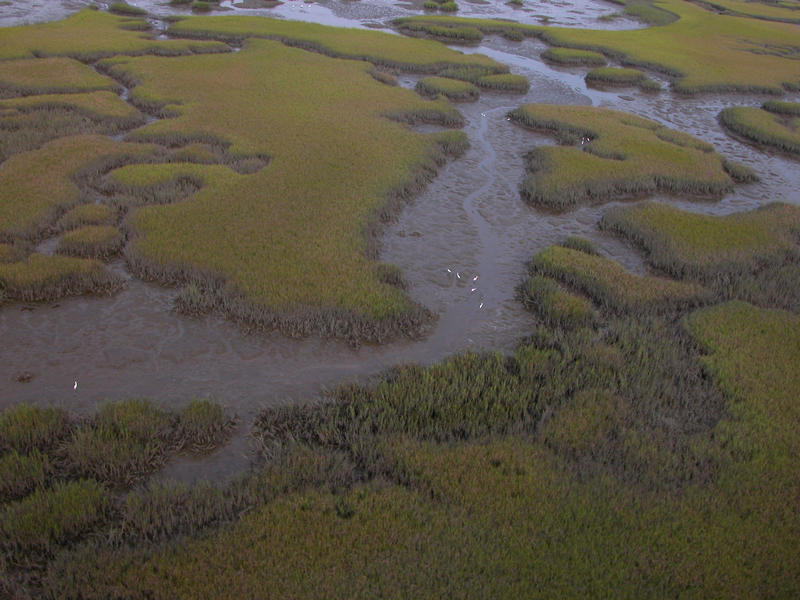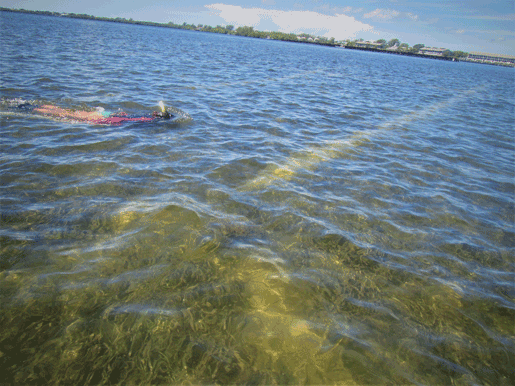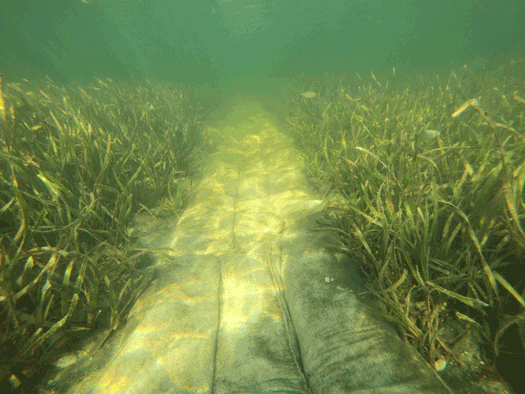The Office of Resilience and Coastal Protection (RCP) works with other agencies to improve seagrass protection, augment habitat recovery through proven scientific restoration techniques, and increase public awareness of the importance of seagrass.
A major threat to seagrasses is propeller scarring. Scarring occurs when boat propellers in shallow water impact roots, stems and leaves of seagrasses, producing long, narrow furrows devoid of vegetation. The damage caused by prop scars can take years to heal. Severe or repeated prop scarring can completely denude and destroy seagrass beds. Derelict, or abandoned, fishing gear can also impact seagrass, creating unique restoration needs. This debris can settle on the bottom and shade out the seagrass, as well as roll through the seagrass meadows in the current, tearing up the rhizomes. Grounded and derelict vessels can also impact seagrass habitat by shading out, eroding and scouring out seagrasses, and removal processes can result in even further impacts.
In 2009, the Florida Legislature created a rule to further protect seagrass by imposing fines to boaters who damage seagrass with their boat propellers (Section 253.04(3)(a), Florida Statutes). Aquatic preserve staff have coordinated with local law enforcement to assist with the enforcement of this rule and have also installed seagrass prop scarring prohibited signs at local boat ramps with access to the aquatic preserves, as well as signage out on the water to notify boaters. Staff also educate aquatic preserve user groups and the general public through presentations and at outreach events about the basics of seagrass and this protection rule.
RCP has employed a variety of seagrass restoration methods throughout the state. These projects have been conducted in Charlotte Harbor, Indian River Lagoon, Biscayne Bay, the Big Bend, the Florida Keys, St. Joseph Bay, St. Andrews Bay and Pensacola Bay. Results have been mixed, and RCP is continuing to monitor these projects and work with other researchers to find more effective ways to revegetate the bottom.
Located in Citrus County, RCP’s St. Martins Marsh Aquatic Preserve has partnered with the UF/IFAS Nature Coast Biological Station to stabilize and restore prop scars with sediment tubes. Sediment tubes accomplish this by returning the scarred areas to ambient elevations, preventing additional erosion and scouring by water currents, and protecting rhizomes from excessive sunlight exposure. The technique involves installing biodegradable fabric tubes filled with sediment into scarred areas that biodegrade in about 12 months. Seagrass beds can be fertilized passively to encourage regrowth through the placement of bird roosting stakes and has been shown to be quite successful, as can be seen in Big Lagoon in Pensacola in Fort Pickens Aquatic Preserve.
The Central Panhandle Aquatic Preserves (CPAP) is currently conducting a Deepwater Horizon NRDA Early Restoration Phase III Project to address boat damage to shallow seagrass beds in the Florida Panhandle by restoring propeller scars located primarily in turtle grass (Thalassia testudinum) habitats in St. Joseph Bay Aquatic Preserve. The project will restore at least two acres of seagrass habitat by deploying sediment tubes into identified propeller scars in St. Joseph Bay Aquatic Preserve. Approximately 45,000 sediment tubes were placed into 370 propeller scars to enhance seagrass recovery by raising the scar elevation to ambient grade, thereby offering suitable habitat for seagrass recruitment. CPAP staff will monitor the success of the restoration efforts over a three-year period.
Northwest Florida Aquatic Preserves has been utilizing salvaged seagrass cores from impacted areas from dock pilings in restoration areas. The salvaged material is utilized to fill propeller scars as well as bare or declining areas and has proven quite successful in the Panhandle estuaries. Historically, Ruppia maritima, or widgeon grass, has been grown via propagules in a laboratory setting and used in restoration efforts in the Panhandle.
Removal of derelict vessels after Hurricane Irma damaged seagrass beds in Lemon Bay Aquatic Preserve. Funds were acquired to restore the prop scars and holes using 1,300 sediment tubes that helped stabilize and bring the sediment back up to grade. Natural colonization of seagrass from adjacent beds has occurred, and monitoring by aquatic preserve staff has documented this restoration effort as a success.
Derelict crab traps have accumulated on the shallow seagrass meadows within the Big Bend Seagrasses Aquatic Preserves' Deadman Bay area in Taylor County. RCP staff are restoring this area by removing debris in the dormant months of winter to allow the seagrass to naturally recover during the summer growing season. Success is being measured through the monitoring of 25 sites within this region as part of a three-year seagrass restoration grant project to assess natural seagrass regrowth within the derelict trap footprint.




